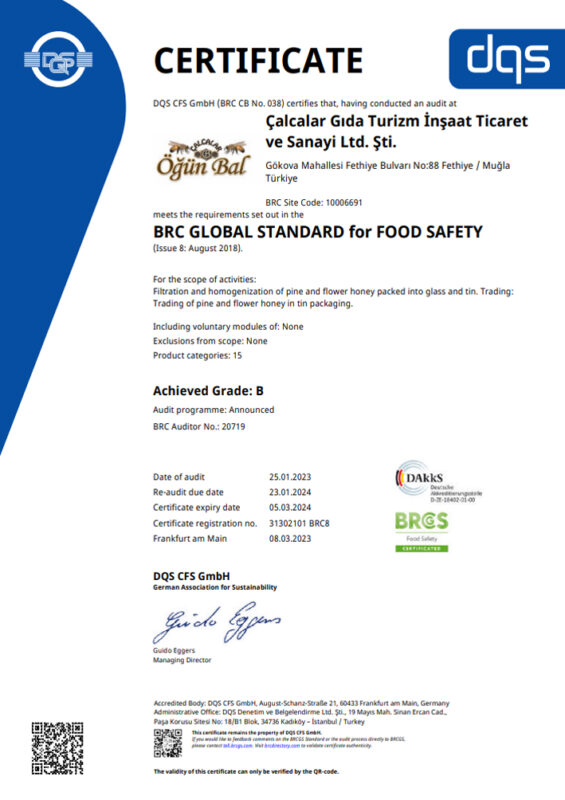Food Safety
In our factory in Gökova, laboratory analyses are carried out according to the latest scientific knowledge and using the latest technology. Thus, we ensure that only honey that meets our high standards is filled into the jar. Honey, which is a completely natural product, is never of the same value. Even honey from the same region can vary from harvest to harvest. For example, the effects of weather conditions or changes in the flowering time of plants can be responsible for these variations. Through careful selection and thorough checks, 3 meals honey ensures that the products supplied fulfil the brand's high quality requirements. That is why we not only check the appearance and taste of our honey, but also carry out more than 10,000 individual analyses every year by us and independent institutes.
Quality certificates
To ensure that our customers receive a product under the most favourable conditions, all processes of selection, acceptance, production and dispatch, from the purchase of raw materials to the delivery of honey, are subject to strict and rigorous controls.



Our analyses and their purposes
- Microscopic pollen analysis and sensory tests, the origin of the flowers as well as the purity of the variety and the ability to declare it as a single variety of honey.
- Physico-chemical analyses examine the authenticity of honey, determining, among other things, the water and enzyme content, the HMF value, the fructose-to-glucose ratio and much more.
- Residue analysis is an examination that ensures the purity of honey in terms of pesticides and bee medicines.
However, we test our honey not only in terms of quality, but also our testing procedures with specially trained employees and established procedural guidelines with transparent processes. After all, our quality is about your taste. 3Öğün Bal branded honey always has the same high quality and typical exquisite taste. This is because its path to the jar follows a precise plan.
Thanks to careful selection and thorough checks, 3 meals honey ensures that the products supplied fulfil the high quality requirements of the brand. That is why we not only check the appearance and taste of our honey, but also carry out more than 10,000 individual analyses every year by us and independent institutes.
Beekeepers carefully selected by 3Öğün Bal provide natural honey from the best honey sources in Turkey. Since they comply with our strict specifications, we get a very diverse product consisting of the world's best honeys.
Honey deliveries arriving in Gokova are first checked externally for purity. The delivered goods are given a warehouse number, which makes them free from defects. Samples for the laboratory are taken from each tin of a honey delivery. Our detailed analysing procedures are only for bottling the best honey as 3Öğün Bal.
A multi-headed taste testing team compiles the delivered honey into a filling batch in such a way that the taste and appearance of our 3Öğün Bal is as consistent as possible from January to December and you can rely on it.
Every honey contains flower pollen, which the bees carry into the hive by clinging to their hairy stems while collecting nectar. By examining the pollen under a microscope, you can determine exactly which plant species and from which region the pollen in honey comes from. This is labour-intensive, requires a lot of know-how and a very good laboratory, but it is worth it: We know exactly where our honey comes from.
Genetically Modified Organisms (GMO) and Honey
Like all natural products, honey is a reflection of the environment. The bee collects nectar and pollen in its natural environment. Genetically modified organisms (GMO) in plants such as rapeseed, maize, soya beans and cotton are now widely used in many parts of the world as part of what is known as green genetic engineering. Honey itself does not contain GMOs, but the pollen in honey can come from a genetically modified plant. However, the proportion of pollen in honey is very low, below 0.1 per cent.
Bees fly for food within a radius of about 7 kilometres, sometimes even more. The flight of bees cannot therefore be controlled by beekeepers and it cannot be ruled out that bees will fly to a GM plant and that pollen will be mixed into honey. In addition, pollen can be carried several hundred kilometres by the wind - this is one of the reasons why pollen from a GM plant can be detected in honey. However, these pollen are not genetically modified organisms - they are inactive in honey and therefore cannot transfer genetic material.
Residue tests
Any honey can only be harvested in an uncontaminated way if the environmental conditions in the harvest area allow it. The bee itself acts as a kind of "biofilter": it is very sensitive to pesticides and other chemicals and therefore often dies before reaching the hive. However, contamination as a result of misuse in a wide variety of fields (agriculture and forestry, fruit growing, private gardens, beekeeping, etc.) cannot be ruled out. The quality control of 3Öğün Bal ensures that contaminated honey is not sold, thanks to the continuous optimisation of the analysis methods and the highest precision in the analysis using the latest equipment.
Sensory and Organoleptic
Sensory evaluation, i.e. grasping the honey with all the senses, is one of the most difficult tasks in honey analysis. Here it is assessed whether a honey meets the requirements placed on it in terms of smell, taste and appearance (e.g. mild, spicy, flavour or odours of a particular honey plant). To fulfil this task, the sensory expert needs years of experience in honey, continuous training and highly sensitive senses. Since the flavours of honey change again and again and honey always has a different composition, there are practically no comparison samples that can be archived in the long term. Nuances can only be stored in memory.
